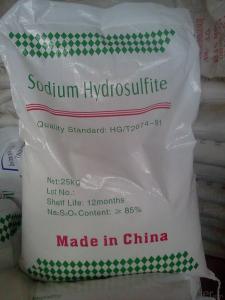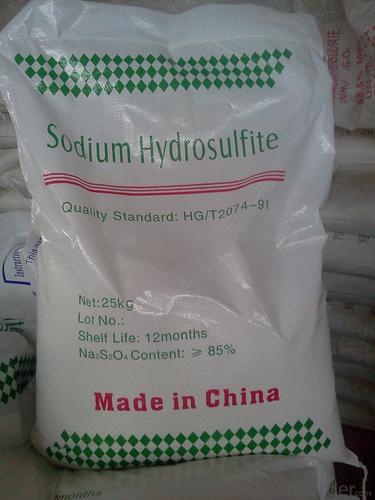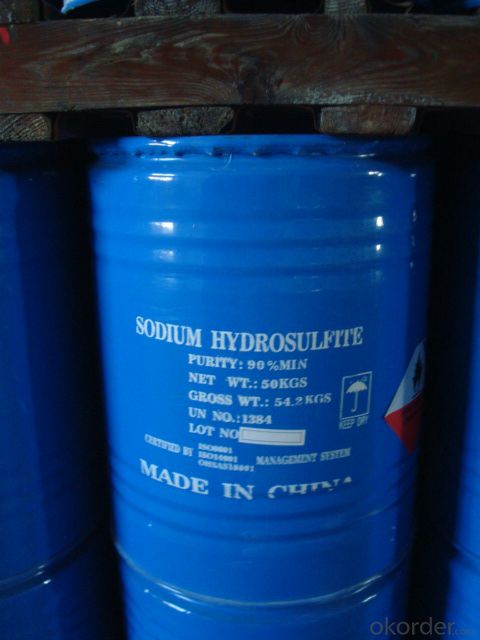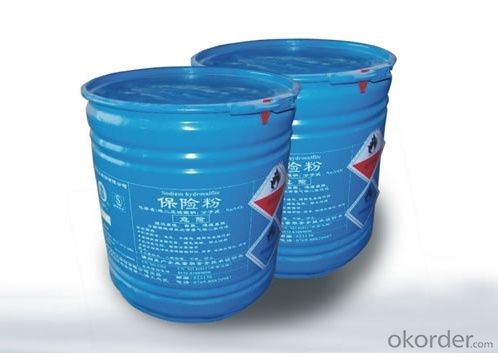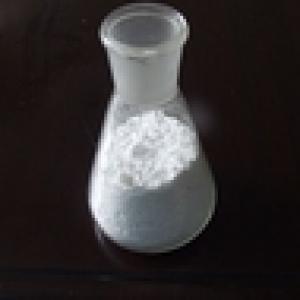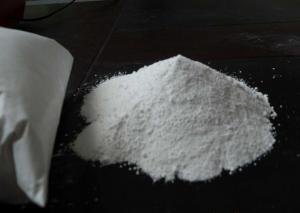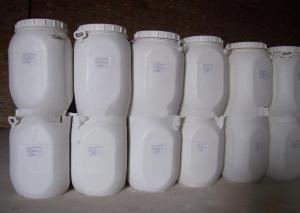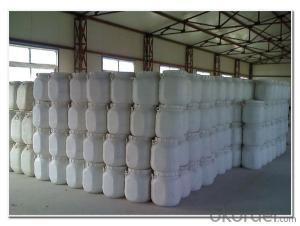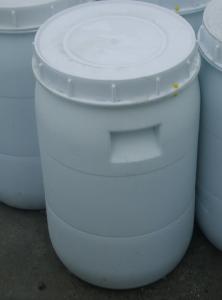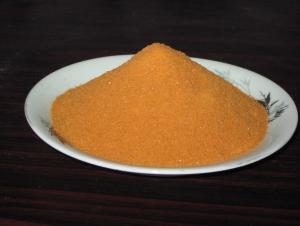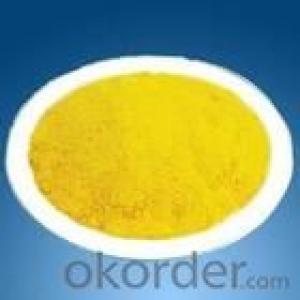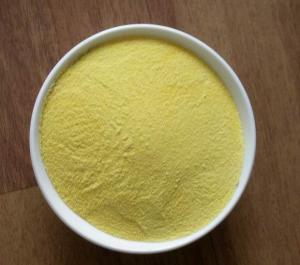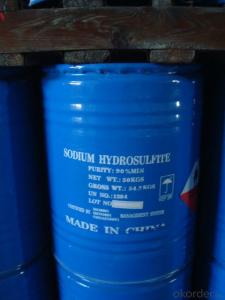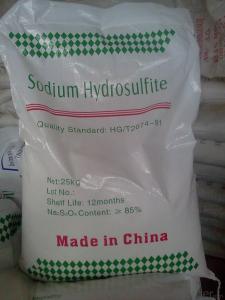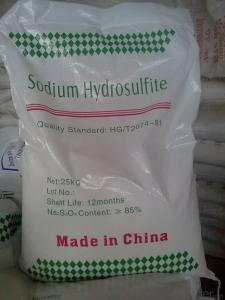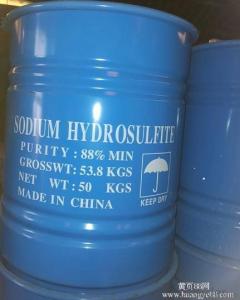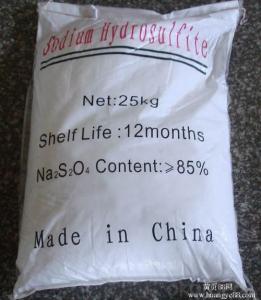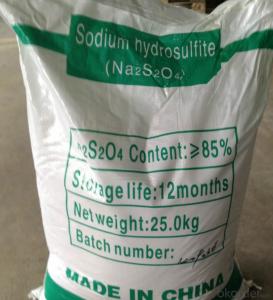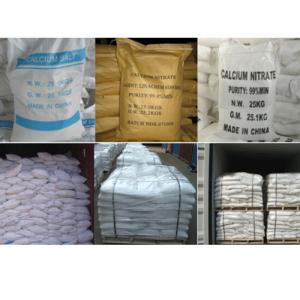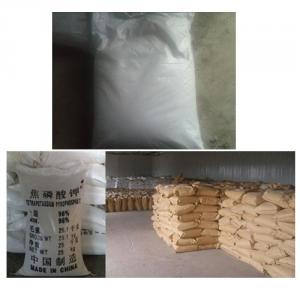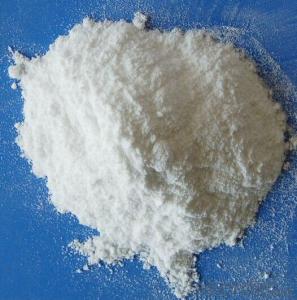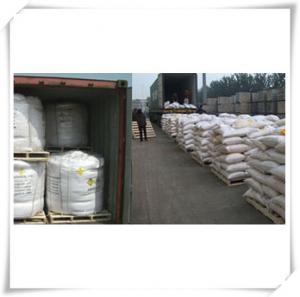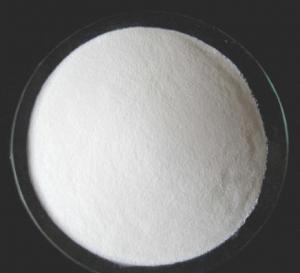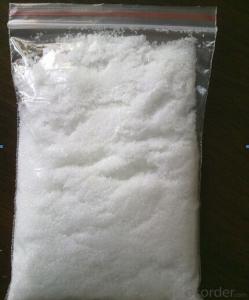Sodium Hydrosulphite with Competitive Quotation and High Quality
- Loading Port:
- Qingdao
- Payment Terms:
- TT or LC
- Min Order Qty:
- 22 m.t.
- Supply Capability:
- 3000 m.t./month
OKorder Service Pledge
OKorder Financial Service
You Might Also Like
1.Structure of Sodium Hydrosulfite Description:
Commodity name: Sodium Hydrosulfite Na2S2O4 Sodium Hydrosulfite Sodium Dithionite Price
Molecular formula:Na2S2O4
Molecular weight:174
CAS Number 7775-14-6
H.S code 28311010
UN number 1384
Class 4.2
2.Main Features of Sodium Hydrosulfite:
1,Widely used in printing and dyeing industry,such as cotton fabrics dyeing auxiliary, silk fabric bleaching.
2,Used as bleaching agent in paper industry
3,Used as bleaching agent,antiseptic agent and antioxidant agent in food industry
4,Used as bleaching agent for soap,oil esters,pulp in light industry
5,Used for producing rongalite,sodium thiosulfate,thiourea,sulfur,benzoic acid,six O(medical),synthetic dyes,also
used copperplate printing,analytical reagent in the chemical industry,etc
6,Used as reducing agent in printing and dyeing industry
3.Sodium Hydrosulfite Images



4.Sodium Hydrosulfite Specification
Standard:HG2932-1999
Index | Technical Grade HG/T 2074-2011 | Food Additive GB 22215-2008 | ||
Na2S2O4, | ≥ 90% | ≥ 88% | ≥ 85% | ≥ 88% |
Iron (Fe), | ≤20ppm | ≤ 20ppm | ≤ 20ppm | ≤ 20ppm |
Zinc (Zn), | ≤ 1ppm | ≤ 1ppm | ≤ 1ppm | ≤ 1ppm |
solution appearance | clear | clear | clear | clear |
EDTA, | / | / | / | qualified |
Arsenic(As), | / | / | / | ≤ 1ppm |
Other heavy metal( As Pb), | ≤ 1ppm | ≤ 1ppm | ≤ 1ppm | ≤ 1ppm |
Formate (As HCHO), | / | / | / | ≤ 0.05% |
water insolubles, | ≤ 0.05% | ≤ 0.05% | ≤ 0.05% | / |
Cadmium (Cd) | / | / | / | ≤ 2ppm |
Plumbum (Pb) | / | / | / | ≤ 5ppm |
5.FAQ
1, are you a trade company or factory?
We are a trade company.
2, what is your main product?
My main product is ammonium chloride all grade. We have special advantage in FEED
GRADE.
3, how do you control the quolity?
We do quolity control by the factory testing department. We also can do FDA,BV, SGS or any orther Third-party testing.
- Q: What is the inorganic salt in the egg
- Eggs are rich in nutrients. It contains protein, fat, vitamins and inorganic salts, enzymes and so on. These nutrients on the body's growth and development, health and longevity have a great effect.
- Q: For science I have to find out what salts are used for but when i search a salt like lithium sulphate it always comes up with "would you like to buy" could you please tell me what these salts are used for*lithium sulphate*zinc nitrate*sodium phosphate
- HI I'M PNT. LITHIUM SULFATE is a white inorganic salt with the formula Li2SO4. It is used to treat bipolar disorder. It is soluble in water, though it does not follow the usual trend of solubility versus temperature — its solubility in water decreases with increasing temperature . This property is shared with few inorganic compounds, such as the lanthanoid sulfates. Lithium sulfate crystals, being piezoelectric, are also used in ultrasound-type non-destructive testing because they are very efficient sound generators. However they do suffer in this application because of their water solubility. ZINC NITRATE: Zinc nitrate (Zn(NO3)2) is a chemical compound used as a mordant in dyeing. It is also a source of zinc ions for chemistry. An example reaction gives a precipitate of zinc carbonate:Zn(NO3)2 + Na2CO3 → ZnCO3 + 2 NaNO3. Conditions/substances to avoid are: reducing agents, organic materials, metal powders, heat and flame, cyanides, sodium hypophosphite, tin(IV) chloride, phosphorus, thiocyanates, carbon, and sulfur. Its Relative Molecular Mass is 189. SODIUM PHOSPHATE: Sodium phosphate are forms of phosphorus, which is a naturally occurring substance that is important in every cell in the body. Sodium phosphate is used to treat constipation and to clean the bowel before surgery, x-rays, endoscopy, or other intestinal procedures. Sodium phosphate enemas are also used for general care after surgery and to help relieve impacted bowels. Sodium phosphate may also be used for other purposes not listed in this medication guide REGARDS, PNT.
- Q: Like the role of B, Fe, Mg, Ca, Mn, Cu, Cl, P, S, N ...., the more specific the better (college entrance examination range)
- The various inorganic salts dissolved in the cells have a certain total concentration, such as human body fluid concentration of 0.9%, frogs of 0.65%, which for maintaining cell osmotic pressure, so that cells maintain a certain shape has an important role, too high or Too low will lead to cell due to water or dehydration to change the cell morphology. There are also a number of buffering systems in the body, which are a group which has a neutralizing effect on the added acid or base so that the pH does not change significantly and therefore plays an important role in maintaining the acid-base balance of the cells.
- Q: What is the time when the maximum number of inorganic salts is needed
- Nitrogen is the basis of many important organic compounds in the body, such as protein, nucleic acid, chlorophyll, enzymes, vitamins, alkaloids and some hormones, etc. Nitrogen is also the basis of genetic material. In all organisms, the protein is most important, it is Often at the center of metabolic activity, which is the primary factor limiting plant growth and yield, and has a significant effect on improving product quality.
- Q: What do we get from the milk?
- (3.00 grams), carbohydrates (3.40 grams), vitamin A (24.00 micrograms), thiamine (0.03 mg), riboflavin (0.14 mg), Nick Acid (0.10 mg), vitamin C (1.00 mg), vitamin E (0.21 mg), calcium (104.00 mg), phosphorus (73.00 mg), sodium (37.20 mg), magnesium (11.00 mg), iron (0.30 mg) Zinc (0.42 mg), selenium (1.94 micrograms), copper (0.02 mg), manganese (0.03 mg), potassium (109.00 mg), cholesterol (15.00 mg)
- Q: Which crop feet can provide C N inorganic salts for fungal growth
- Plant growth requires a variety of inorganic salts, which require the most is nitrogen, phosphorus, potassium containing inorganic salts. If a lack of some inorganic salts, plants can not grow normally. Kind of crops need fertilization, farm manure contains organic matter, the microbial decomposition of the soil will produce a large number of inorganic salts for plant growth and utilization, the role of fertilizer is to provide a variety of plant growth of inorganic salts. Therefore, in agricultural production, the application of fertilizer and farm manure is intended to provide a variety of inorganic salts for crops.
- Q: What cells produce the collagen and inorganic salts of bone matrix?
- Inorganic Salts In Bone
- Q: Does the urine and urine contain inorganic salts? Anxious
- When the blood flows through the glomerular, in addition to blood cells and macromolecules of protein, the plasma part of the water, inorganic salts, glucose and urea and other substances, can be filtered through the glomeruli into the renal capsule, the formation of urine ; When the original urine through the renal tubular, which is useful for the human body substances, including most of the water, all the glucose and part of the inorganic salt, reabsorbed by the renal tubules, and into the capillaries outside the renal tube, To the blood; in the renal tubular reabsorption at the same time, renal tubular epithelial cells will produce substances (such as ammonia) secretion into the renal tubular bureaucratic, and the original urine of other waste, such as urea, part of the water and inorganic Salt, etc. from the renal tubular effusion, the formation of urine. Therefore, plasma, urine and urine are contained in the material is water, inorganic salts, urea.
- Q: Calcium is not an inorganic salt
- Calcium salt is determined whether it is inorganic salt depends on its acid, if it is organic acid synthesis of calcium salt is organic salt, if it is inorganic acid synthesis of calcium salt is inorganic salt. The main basis for determining the inorganic salts is whether or not organic reactants are involved in the formation process.
- Q: My body fat rate 14.6 normal body fat percentage 31.2 is more than the normal value I do not know the difference between the two please God answer ah Thank you very grateful and then those elements of my lack of God is the situation ah I love meat is not a vegetarian! And I super love to eat eggs! And my super love to drink water!
- The gym can also be measured
Send your message to us
Sodium Hydrosulphite with Competitive Quotation and High Quality
- Loading Port:
- Qingdao
- Payment Terms:
- TT or LC
- Min Order Qty:
- 22 m.t.
- Supply Capability:
- 3000 m.t./month
OKorder Service Pledge
OKorder Financial Service
Similar products
Hot products
Hot Searches
